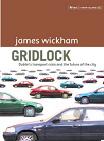Book - GRIDLOCK: Dublin's Transport Crisis and the Future of the City

Gridlock argues that proper public transport is essential for Dublin. Traffic jams are a nuisance and impose costs on business; the city's car addiction makes the city environmentally unsustainable. Yet ultimately far more is involved. Public transport is necessary if the people who live in Dublin are to fully become citizens of Dublin, and it is not too exaggerated to say that proper public transport is necessary if Dublin is to be a real capital city for the people of Ireland. For Gridlock author James Wickham has drawn on his research project comparing transport in Dublin with three other European cities (Athens, Bologna and Helsinki); he also uses material on European transport policy.
Dublin's rising car usage is not an inevitable consequence of rising affluence or economic growth - it is the result of a series of social and above all political choices. The book shows how in the second half of the 20th century, Dublin's public transport system was destroyed. Even before the boom of the 1990s, the city was becoming more and more suburbanised, and in a way that exacerbated its inhabitants' dependency on the car. By 1990 nearly 60% of all journeys to work in Dublin were by private car - a level exceeded by Bangkok or Athens, but far above some richer European cities such as Bologna or Helsinki.
Car dependency has negative consequences for the city as a whole. Some of the environmental damage can reduced or even eliminated by new technologies (e.g. alternative fuels), other environmental issues - from noise to land usage - seem more intractable. Indeed, Gridlock argues that Dublin's car dependency is inherently resource intensive and generates a lifestyle with negative impacts on public health.
While most people would probably agree that car dependency is in some vague sense 'bad for the environment', there is much less discussion of its social policy aspects. Gridlock argues that Dublin's car dependency exacerbates poverty and social exclusion. The city is designed for people with cars, which makes the car a necessity not a luxury. And as with other necessities, those who do not have a car - whether they are too young, too old or quite simply too poor - run the risk of being excluded from what is now defined as normal life. In particular Gridlock compares a working class area of Dublin with an equally deprived area in Helsinki. This shows that for those people in Dublin without a car their access to jobs is restricted, they find it difficult to move around the city, they are not full citizens. In Helsinki by contrast, better public transport ensures that doing without a car may mean missing out on excursions to the countryside, but has little impact on job prospects or social life.
Gridlock also shows how Dublin's car dependency undermines the quality of life of all citizens. It creates private spaces and destroys public space, while public transport potentially creates a collective good and a public resource, an area of shared public life that is shaped by public rather than private values. Dublin's poor public transport means that even in the new affluent apartment areas of the inner city, where the city planners are encouraging higher density housing, the private car remains essential.
Today it is frequently assumed that the problem with public transport is state ownership. Who wants to defend CIE? Yet Gridlock is sceptical of private enterprise fanatics who claim that the public sector is inherently inefficient and unable to innovate. Comparative evidence shows that the debate over privatisation is a red herring: where public transport is provided by private companies it is not inevitably better than publicly owned enterprises. Indeed, there is now much evidence the other way round: privatising public transport and expanding competition can often undermine public services.
Achieving proper public transport in Dublin will certainly require institutional change. The real issue, so Gridlock shows, is the need for a powerful city government and on some form of transit authority. Until the city is responsible for its own transport decisions, transport will remain a mess. Rather than asking what the minister is going to do next, we should be asking when he is going to allow Dubliners to decide on Dublin's transport.
Gridlock ends with a scenario for a different Dublin: a multi-modal city in which citizens have genuine choices as to how they move around, and indeed, as to how they will live. At the centre of this scenario is an expanded pavement city - a central area in which people move around by walking and short range public transport (above all the tram); it includes world class public spaces, such as a pedestrianised plaza between College Green and the National Gallery. This different Dublin is also a polycentric city, in which the city centre is the largest of a series of urban cores in which short trips without a car have again become feasible. Suburban centres are town centres, not just shopping malls.